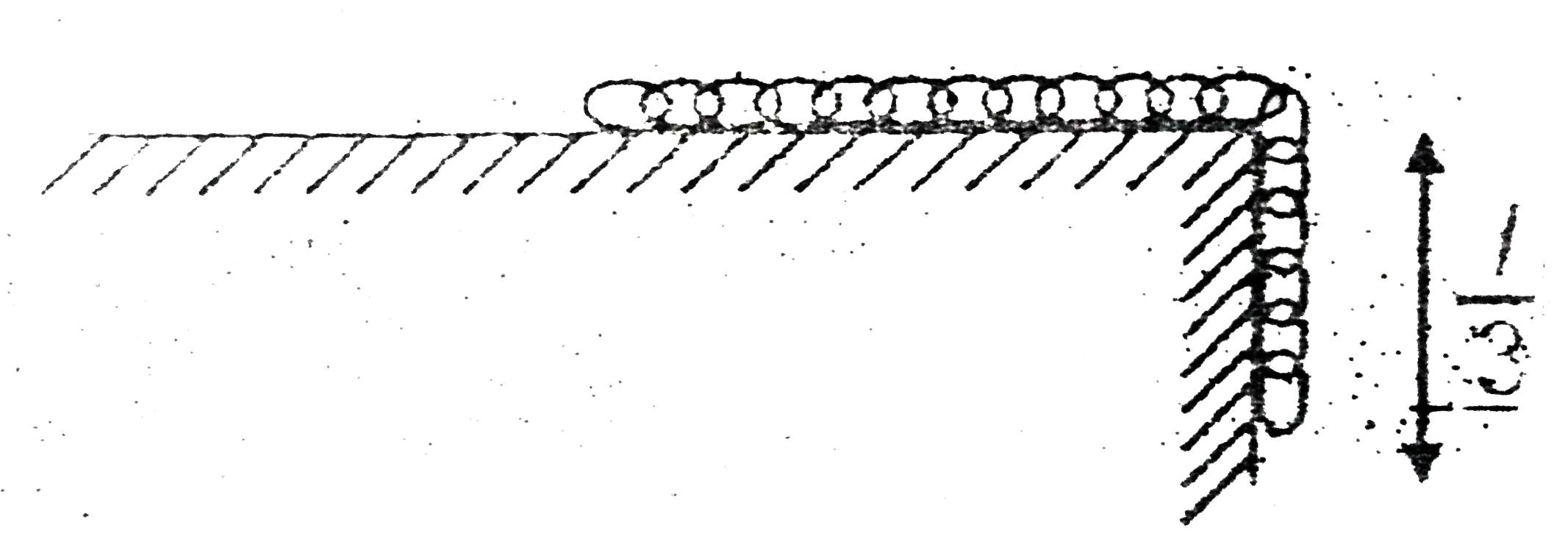A uniform chain of mass M and length L is lying on a frictionless table in such a way that its 1/3 parts is hanging vertically down. The work done in pulling the chain up the table is
MgL18
MgL9
MgL6
MgL3
The correct Answer is:A
To solve the problem of calculating the work done in pulling a uniform chain of mass M and length L such that 13 of it is hanging vertically down from a frictionless table, we can follow these steps:
1. Identify the mass of the hanging part of the chain:
Since 13 of the chain is hanging, the length of the hanging part is:
Lh=L3
The mass of the hanging part can be calculated as:
Mh=M3
2. Determine the gravitational force acting on the hanging part:
The force due to gravity acting on the hanging mass is:
F=Mh⋅g=M3⋅g
3. Consider an infinitesimal element of the hanging chain:
Let’s consider an infinitesimal length dx of the chain that is at a distance x below the edge of the table. The mass of this infinitesimal element is:
dm=ML⋅dx
4. Calculate the force acting on this infinitesimal element:
The gravitational force acting on this infinitesimal mass is:
dF=dm⋅g=ML⋅g⋅dx
5. Determine the work done to lift this infinitesimal element:
The work done dW in lifting this element from a height x to the table (which is at height 0) is given by:
dW=−dF⋅x=−(ML⋅g⋅dx)⋅x
The negative sign indicates that the force and displacement are in opposite directions.
6. Integrate to find the total work done:
To find the total work done W in pulling the entire hanging part of the chain back onto the table, we integrate from x=0 to x=L3:
W=−∫L30(ML⋅g⋅x)dx
7. Perform the integration:
W=−ML⋅g⋅∫L30xdx
The integral of x is:
∫xdx=x22
Evaluating from 0 to L3:
∫L30xdx=(x22)L30=12(L3)2=L218
8. Substituting back into the work equation:
W=−ML⋅g⋅L218=−MgL18
Since work done is a scalar quantity, we can take the absolute value:
W=MgL18
Final Answer:
The work done in pulling the chain up onto the table is:
W=MgL18
Since 13 of the chain is hanging, the length of the hanging part is:
Lh=L3
The mass of the hanging part can be calculated as:
Mh=M3
The force due to gravity acting on the hanging mass is:
F=Mh⋅g=M3⋅g
Let’s consider an infinitesimal length dx of the chain that is at a distance x below the edge of the table. The mass of this infinitesimal element is:
dm=ML⋅dx
The gravitational force acting on this infinitesimal mass is:
dF=dm⋅g=ML⋅g⋅dx
The work done dW in lifting this element from a height x to the table (which is at height 0) is given by:
dW=−dF⋅x=−(ML⋅g⋅dx)⋅x
The negative sign indicates that the force and displacement are in opposite directions.
To find the total work done W in pulling the entire hanging part of the chain back onto the table, we integrate from x=0 to x=L3:
W=−∫L30(ML⋅g⋅x)dx
W=−ML⋅g⋅∫L30xdx
The integral of x is:
∫xdx=x22
Evaluating from 0 to L3:
∫L30xdx=(x22)L30=12(L3)2=L218
W=−ML⋅g⋅L218=−MgL18
Since work done is a scalar quantity, we can take the absolute value:
W=MgL18
The work done in pulling the chain up onto the table is:
W=MgL18
Topper's Solved these Questions
Similar Questions
A uniform chain of mass m and length l is lying on a horizontal table with one-third of its length hanging over the edge of the table.

What is the speed of the chain, when it just loses contact with the table?
View SolutionA uniform chain of mass m & length L is kept on a smooth horizontal table such that Lnportion of the chaing hangs from the table. The work dione required to slowly bringsthe chain completely on the table is
View Solution
Knowledge Check
A chain of uniform mass m and length L is held on a frictionless table in such a way that its 1nth part is hanging below the edge of table. The work done to pull the hanging part of chain is :−
A√nBnCn−3Dn−2A uniform chain of length L and mass M is lying on a smooth table and one-third of its length is hanging vertically down over the edge of the table. If g is the acceleration due to gravity, the work required to pull the hanging part on to the table is
AMgLBMgL3CMgL9DMgL18
A uniform cable of mass 'M' and length 'L' is placed on a horizontal surface such that its (1n)th part is hanging below the edge of the cable upto the surface, the work done should be :
View SolutionA uniform chain of mass m and length l is lying on a horizontal table with one-third of its length hanging over the edge of the table.

If the chain is limiting equlibrium, what is the coefficient of friction for the contact between table and chain?
View SolutionA uniform chain of mass m and length l is lying on a horizontal table with one-third of its length hanging over the edge of the table.

If a gentle push is given to hanging end, it will start moving down. What is the change in gravitational potential energy of the chain, as it just leaves the table?
View SolutionA uniform chain has a mass M and length L. It is placed on a frictionless table with length l0 hanging over the edge. The chain begins to slide down. Ten, the speed v with which the end slides down from the edge is given by
View SolutionA uniform chain of length l and mass m is placed on a smooth table with one-fourth of its length hanging over the edge. The work that has to be done to pull the whole chain back onto the table is :
View SolutionA uniform chain of mass 4 kg and length 2 m is kept on table such that 3/10th of the chain hanges freely from the edge of the table. How much work has to be done in pulling the entire chain on the table?
View Solution